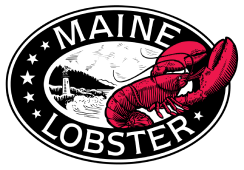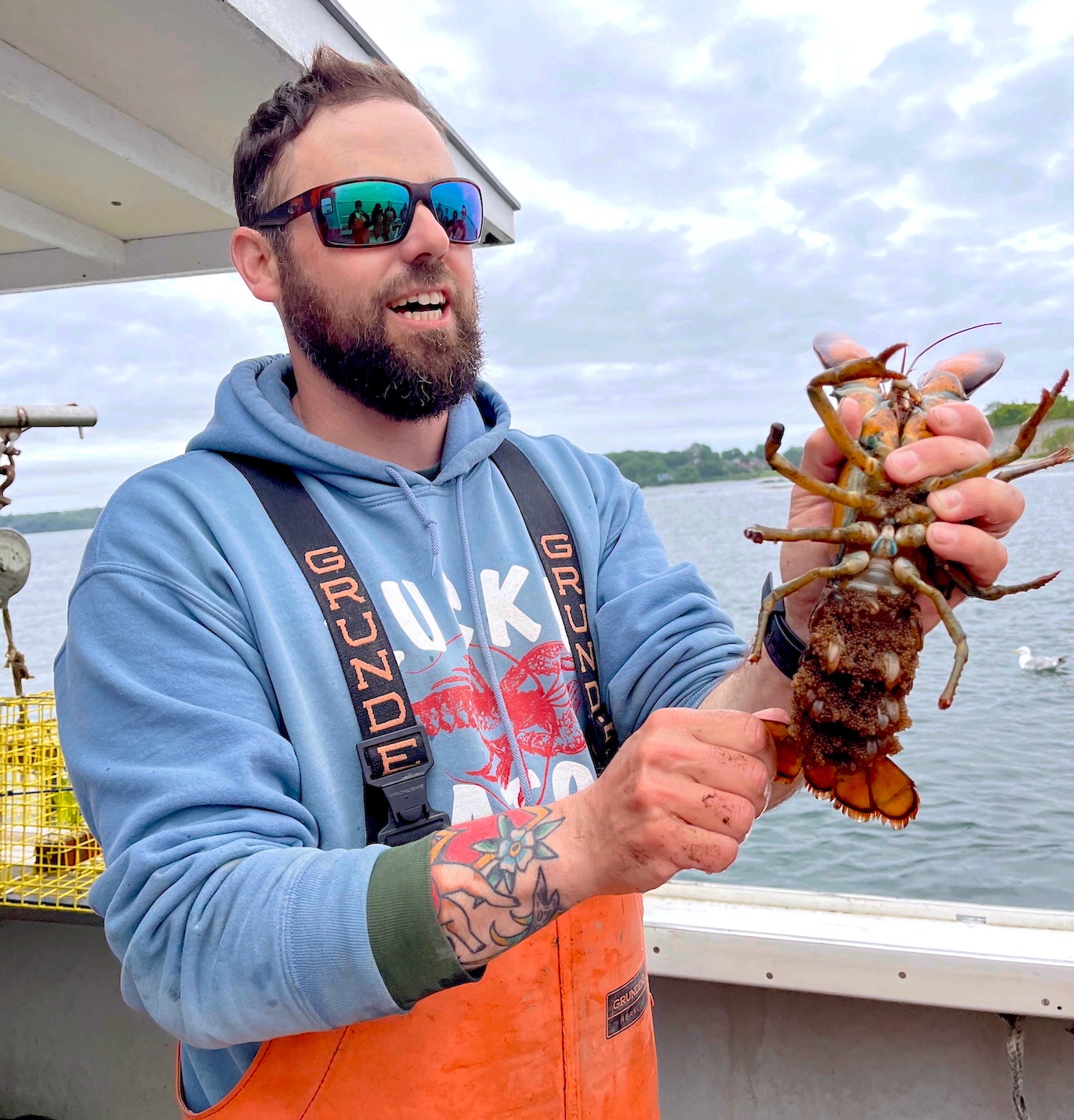
An inside look at Maine Lobster’s booming business and how sustainability stays top of mind.
Growing up in New England, I’ve been around a lobster or two. I even used to break down live ones as a teenage kitchen apprentice in Boston. But admittedly, they weren’t serving baked stuffed lobsters at my western Maine Jewish summer camp, and we weren’t hauling traps in my suburban hometown. So I was back up in Maine to finally really learn about its most coveted culinary treasure, and I had to start with the basics.
Maine Lobster fishery is one of Maine’s most important economic engines and a cultural touchstone that defines the state for many around the country and the world. Generations of sustainable fishing practices—and truly remarkable foresight—have ensured exponential growth in local lobster populations and a robust industry centered around selling live lobster, fresh and frozen processed meat, and, increasingly, value-added products.
“My dad was the first licensed lobster processor in the state of Maine,” says Luke’s Lobster CEO Luke Holden, who represents the third generation of his family involved in the lobster industry. “So I grew up on the back of boats.” As we don layers of PPE and tour his facility, I watch as lobsters enter the steam cooker and get cracked and handpicked on the other side by Holden’s highly skilled staff. The meat will continue on to his 28 restaurants around the country (and nine in Singapore and Japan) or into his line of consumer packaged goods, like lobster roll kits, sold at Whole Foods and other markets.
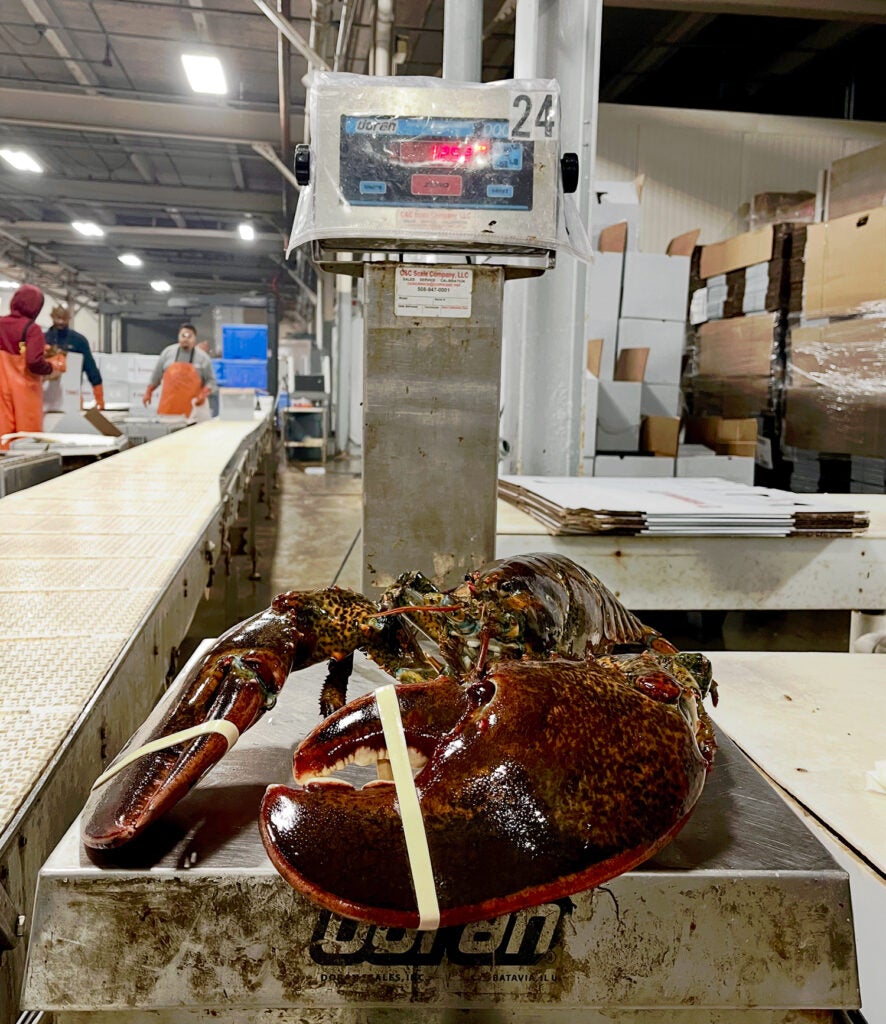
An enormous lobster gets weighed at Ready Seafood in Portland.
“It takes a really significant team and investment to actually create sustainable value from the Maine Lobster harvest,” he says. “And none of that happens overnight.”
The boom in the Maine Lobster fishery has become really significant in the past 30 or so years—in part because of size limits, trap limits, and a long-standing practice of protecting fertile females that dates to the late 19th century. These days, the annual lobster harvest tends to hover around 100 million pounds, up from roughly one-third of that amount in the 1990s. “As we caught more,” explains Holden, “we needed to find more ways to market and sell it. And that’s when processing became a thing. Every fisherman’s worst nightmare is not being able to sell the product.”
At Ready Seafood, a major dealer and processor on Portland’s busy commercial waterfront, lobsters that have been caught up and down Maine’s coast are stored in enormous open tanks of seawater before being shipped live around the world or processed. “This is a highly relationship-based business,” explains CEO Wesley Smith, tracing his company’s inventory from lobstermen to the network of wharves that sell to dealers like his. “It could be a co-op, or it could be a privately owned enterprise—it’s a place on the water that unloads from the fishermen, pays the fishermen, and then sells them somewhere else.” In an industry dependent on relationships, how did they build theirs? “We were started by two fishermen, so we had that street-level credibility.”
It’s the type of refrain I hear all around Portland. But this deep tie to lobstering is even stronger up in the Midcoast, the gorgeous region of rocky inlets and fishing towns along Route 1 between Portland and Acadia. “It’s much more of a way of life up here,” says Bree Birns, an owner of McLoons Lobster Shack on Spruce Head Island in South Thomaston. “Even if you’re not from a fishing family, you’re connected to it somehow,” she adds. But she is from a family in the industry.
Growing up in Cape Elizabeth, just south of Portland, Birns was exposed to the industry through her father, a lobster dealer. Today her family owns the picturesque wharf that’s home to McLoons; trucks drive up from Portland each day to collect the catch, but the shack gets first dibs. “We have about a dozen lobstermen who sell to us right here,” she says. The lobster ends up steamed, picked for lobster stew, or cradled in a buttered bun for McLoons’ beloved lobster rolls. “Everybody’s got their own opinions about what makes a great lobster roll,” Birns says, “but I think it’s simple: fresh lobster meat and a nicely toasted roll. It’s just a perfect summer Maine thing to eat.”
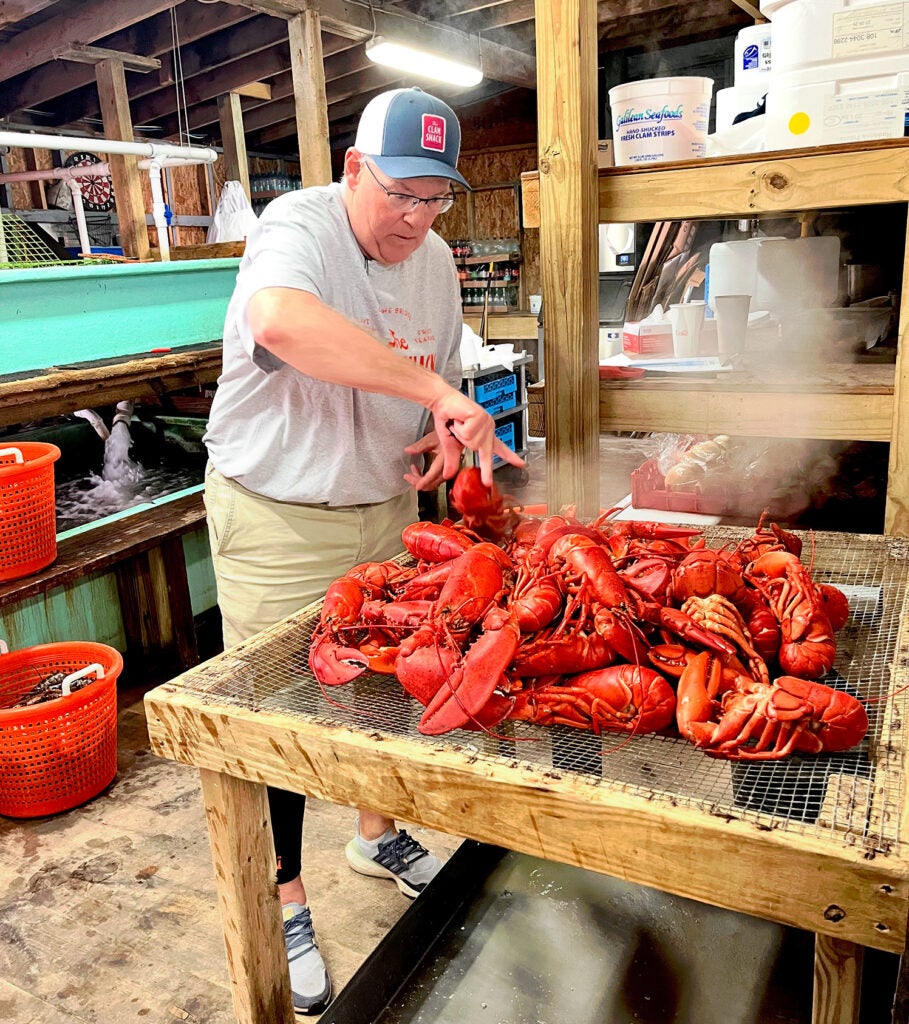
Owner Steve Kingston admires perfectly cooked lobsters fresh out of the saltwater kettle at The Clam Shack.
Further north in Belfast, upstart shack Must Be Nice Lobster is the passion project of lobsterman Sadie Samuels, who spends all morning fishing before coming in to run her busy restaurant. “There’s nobody else here doing this who’s also the fisherman,” she says, “and people respond really well to that.”
Samuels grew up fishing with her father, who’s been lobstering for more than 50 years. “As working people on the waterfront, we sometimes take it for granted,” she says, “but so many places are so far removed from where their food comes from.” After years of putting in so much hard work herself, she understands viscerally what it takes to get lobster from sea to table—and what makes that lobster so special. “All of our practices and regulations make it so that we know we have the best-quality seafood,” she says. “We’re so lucky.”
Back in Portland, I join a boat tour operated by Lucky Catch Cruises, which offers tourists an opportunity to see lobstering up close—its guides are commercial lobstermen themselves. “There’s a huge barrier to entry in licensing,” Captain Dave Laliberte explains, “so the best way to lobster fish, if you want to, is to join a tour.” In order to earn his commercial license, Laliberte had to undergo a process that includes a two-year apprenticeship and a long wait. “I think currently the waitlist would take 15 or more years,” he says. But the wait is worthwhile. A commercial license allows lobstermen to fish up to 800 traps—an important aspect of conservation; it used to be unlimited—while a “demonstration license,” held by other tour companies, only allows for catch and release.
On the boat, we bait traps, haul them in, and are lucky to catch a fertile female laden with thousands of tiny dark eggs. I watch as Laliberte notches her tail and throws her back in, ensuring that she’ll continue to breed, before we use a specialized instrument to rubber-band the claws of the keepers that fit within legal size limits. It’s eye-opening and quite intuitive to see these sustainable practices employed in real time.
Tourism in Maine—which is, after all, Vacationland—has a symbiotic relationship with the lobster industry, and experiences like these are also an important way to put human faces and stories to a resource that those “from away” have surely come here to enjoy. “Lobster does a lot of the work in getting people on the boat,” Laliberte says. And they can even buy what’s been caught to cook later.
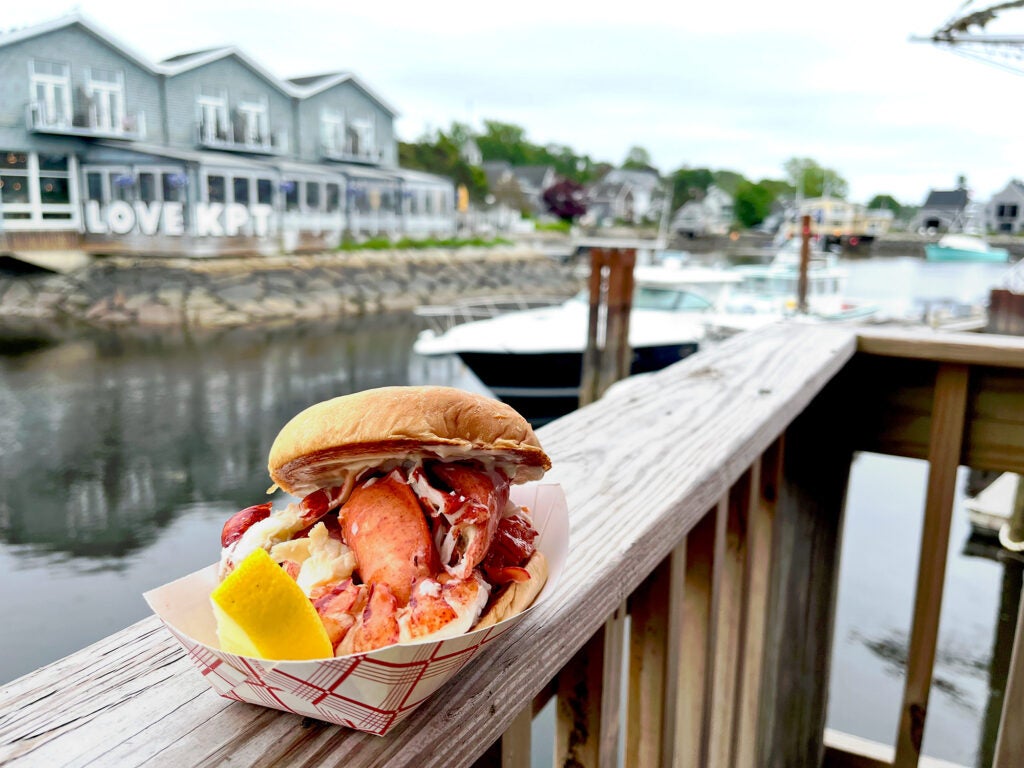
The outstanding lobster roll at Kennbunkport’s The Clam Shack is served on a hamburger bun.
Down in Kennebunkport, south of Portland, those rubber bands I helped put on the lobsters’ claws are coming off at the Clam Shack, located on a scenic bridge near where the Kennebunk River empties into the Atlantic Ocean. Owner Steve Kingston swears you can taste the bands if they’re left on for steaming, especially with new shell lobster. Most available during the peak season of July to October, new shell lobster has the sweeter, more tender meat that Maine Lobster is known for.
And in the Clam Shack’s award-winning lobster rolls, that sweet, tender meat is enhanced by briny notes of the local seawater it’s been steamed in. “There’s something unique about the salinity of the water and the sweetness of lobster meat,” he tells me. “It’s wild. But it makes sense—that’s where it came from.”
Kingston’s rolls are the object of some fascination in part because they are served, nontraditionally, on a hamburger bun. Like him, I see the advantages of this meat-to-bread distribution, and the thing is: there are even more provocative rolls in Maine. Take Eventide, the Portland small-plates pioneer that serves its brown-butter lobster roll on a soft, springy bun made from Chinese bao dough. Or Twelve, a prix-fixe spot with an impressive pedigree that serves its lobster roll in a meticulously laminated puff pastry (as a supplementary item).
I’m not just being diplomatic—they’re all good. Of course, lobster rolls aren’t the only thing Mainers make from their prized natural resource. “When most people walk in our door,” says Eventide chef de cuisine Jared Leaman-Farley, “they know they’ll find lobster, but it’s going to be in a different form than those tried-and-true methods.” To that end, he offers a green curry lobster stew, and he was recently showering Maine asparagus with an addictive lobster XO sauce, augmented with house-fermented doubanjiang.
Eating all this definitely feels different with the added context. Back on the water, my fellow tourists are shown a male and a female lobster, and one of the guides pulls me aside. “You probably already know this,” she says, “but do you know which is which?” It’s been an eye-opening trip, and we covered this on day one at Luke’s, so I confidently assign sexes to each and await her praise. “Well,” she says, “you had a fifty-fifty chance.” There’s always more to learn.
This feature is supported by the Maine Lobster Marketing Collaborative. Get Maine Lobster delivered directly to your door by visiting https://lobsterfrommaine.com/how-to-buy/.
